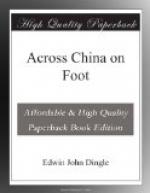This pent-up volume of water, always endeavoring to break away the rocky bonds which have harnessed it, rushes roaring as a huge, tongue-shaped, tumbling mass between its confines of rock and reef. Breaking into swift back-wash and swirls in the bay below, it lashes back in a white fury at its obstacles. Fortunately for the junk traffic, it improves rapidly with the advent of the early spring freshets, and at mid-level entirely disappears. The rapid is at its worst during the months of February and March, when it certainly merits the appellation of “Glorious Dragon Rapid,” presenting a fine spectacle, though perhaps a somewhat fearsome one to the traveler, who is about to tackle it with his frail barque. A hundred or more wretched-looking trackers, mostly women and children, are tailed on to the three stout bamboo hawsers, and amid a mighty din of rushing water, beating drums, cries of pilots and boatmen, the boat is hauled slowly and painfully over. According to Chinese myths, the landslip which produced the rapid was caused by the following circumstance. The ova of a dragon being deposited in the bowels of the earth at this particular spot, in due course became hatched out in some mysterious manner. The baby dragon grew and grew, but remained in a dormant state until quite full grown, when, as is the habit of the dragon, it became active, and at the first awakening shook down the hill-side by a mighty effort, freed himself from the bowels of the earth, and made his way down river to the sea; hence the landslip, the rapid, and its name.
FUH T’AN RAPID (OR TIGER RAPID)
Eight miles beyond Wan Hsien. Very savage during summer months, but does not exist during low-water season. Beyond this point river widens considerably. Twenty-five miles further on travelers should look out for Shih Pao Chai, or Precious Stone Castle, a remarkable cliff some 250 or 300 feet high. A curious eleven-storied pavilion, built up the face of the cliff, contains the stairway to the summit, on which stands a Buddhist temple. There is a legend attached to this remarkable rock that savors very much of the goose with the golden eggs.
Once upon a time, from a small natural aperture near the summit, a supply of rice sufficient for the needs of the priests flowed daily into a basin-shaped hole, just large enough to hold the day’s supply.
The priests, however, thinking to get a larger daily supply, chiselled out the basin-shaped hole to twice its original size, since when the flow of rice ceased.
KWAN IN T’AN (OR GODDESS OF MERCY RAPID)
Two miles beyond the town of Feng T’ou. Like the Fuh T’an, is an obstacle to navigation only during the summer months, when junks are often obliged to wait for several days for a favorable opportunity to cross the rapid.




